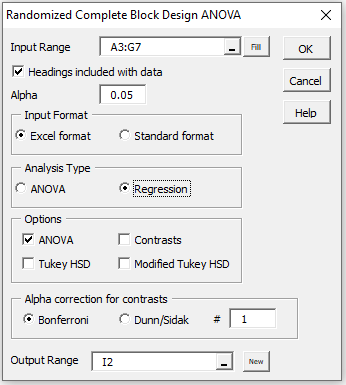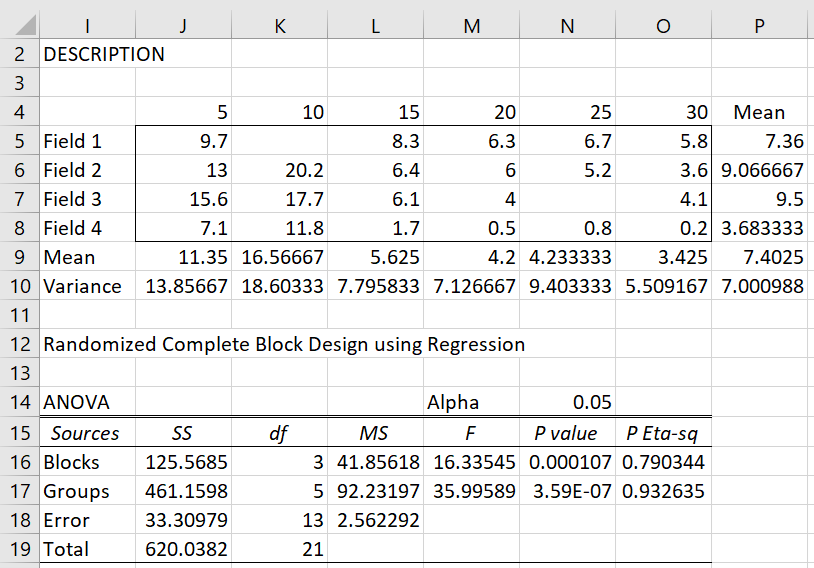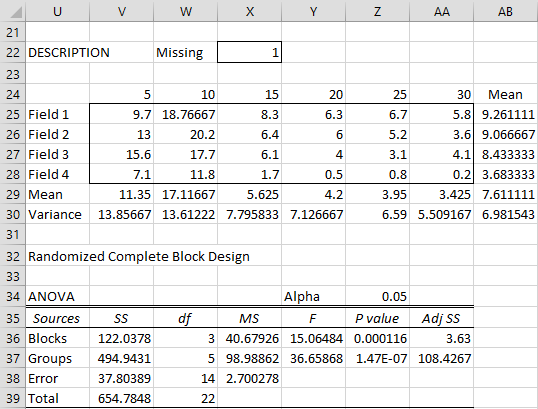Data Analysis Tool
We can use the Real Statistic Randomized Complete Block Anova data analysis tool to address Example 1 of RCBD with Missing Data using Regression. This is done by pressing Ctrl-m and choosing the Randomized Complete Block Anova option from the Anova tab of the Multipage menu that appears (or the Analysis of Variance option if using the original user interface). Next fill in the dialog box that appears as shown in Figure 1.
Figure 1 – RCBD dialog box
The output is as shown in Figure 2 (slightly modified to fit better on the webpage).
Figure 2 – RCBD: Regression approach using Real Statistics
Note that range J16:J18 contains the worksheet array formula =SS_RCBD(J5:O8,FALSE) (see below for an explanation of this formula), cell J19 contains the formula =DEVSQ(J5:O8), although it could also be calculated by =SUM(J6:J18). Cell K16 contains the formula =ROWS(J5:O8)-1, cell K17 contains =COLUMNS(J5:O8)-1, cell K19 contains the formula =COUNT(J5:O8)-1 and cell K18 contains =K19-K16-K17.
Worksheet Function
Real Statistics Function: The Real Statistics Resource Pack provides the following array function.
SS_RCBD(R1, std): outputs a column array with the values SSBlock, SSGroups and SSError for the data in range R1 based on regression; if std = TRUE then R1 is assumed to be in standard (stacked) format and when std = FALSE (default) it is assumed to be in Excel format
Alternative Data Analysis Tool
The Real Statistic Randomized Complete Block Anova data analysis tool can also be used to create an RCBD model when one data element is missing. For Example 1 of RCBD with One Missing Data Element, this done by choosing the ANOVA Analysis Type in Figure 1. The output is as shown in Figure 3.
Figure 3 – RCBD: Imputation approach using Real Statistics
Note that cell X22 contains the formula =ROWS(B4:G7)*COLUMNS(B4:G7)-COUNT(B4:G7) (references are to the cells in Figure 1 of RCBD with One Missing Data Element) and range V25:AA28 contains the array formula =RCBDMissing(B4:G7) (this formula and the next two formulas are described below). Cell AA36 contains the worksheet formula =RCBDAdjSS(B4:G7,TRUE) and cell AA37 contains the formula =RCBDAdjSS(B4:G7,FALSE).
In addition, cell V36 contains the formula =(W37+1)*DEVSQ(AB25:AB28)-AA36, cell V37 contains the formula =(W36+1)*DEVSQ(V29:AA29)-AA37, cell V39 contains =DEVSQ(V25:AA28)-AA36-AA37 and cell V38 contains =V39-V36-V37. Cell W38 contains the worksheet formula =(W36+1)*(W37+1)-1-X22.
Observation: The approach described above, as well as the new functions and revisions to the data analysis tool, can also be used for Two Factor ANOVA without Replication and for Repeated Measures ANOVA when there is one missing data element.
More Worksheet Functions
Real Statistics Functions: The Real Statistics Resource Pack provides the following functions.
RCBDMissing(R1): outputs an array identical to R1 except that if one cell is non-numeric (representing a missing data value), then that cell is replaced by the imputed value (as described above); if no cells are missing then the output is a copy of R1, while if more than one cell is missing then an error cell values are returned.
RCBDAdjSS(R1, b) = the adjusted SS value for rows (i.e. Blocks) if b = TRUE or for columns (i.e. Groups) if b = FALSE
Observations
The Regression option can also be used when the data is formatted in standard (stacked) format. The imputation when one cell is missing can also be used with data in standard (stacked) format (selecting the ANOVA Analysis Type).
The regression approach described above, as well as the new functions and revisions to the data analysis tool, can also be used for Two Factor ANOVA without Replication and for Repeated Measures ANOVA when there are one or more missing data elements.
E.g. for Repeated Measures ANOVA when there is one missing data element, you can run the RCBD data analysis tool and then use the GGEpsilon and HFEpsilon functions on the complete data (including the one imputed value).
Examples Workbook
Click here to download the Excel workbook with the examples described on this webpage.
References
Montgomery, D. C. (2013) Design and analysis of experiments, 8th ed. Wiley
https://faculty.ksu.edu.sa/sites/default/files/douglas_c._montgomery-design_and_analysis_of_experiments-wiley_2012_edition_8.pdf
Craig, B. A. (2018) Randomized complete block design (RCBD)
https://www.stat.purdue.edu/~bacraig/notes514/topic11a.pdf


